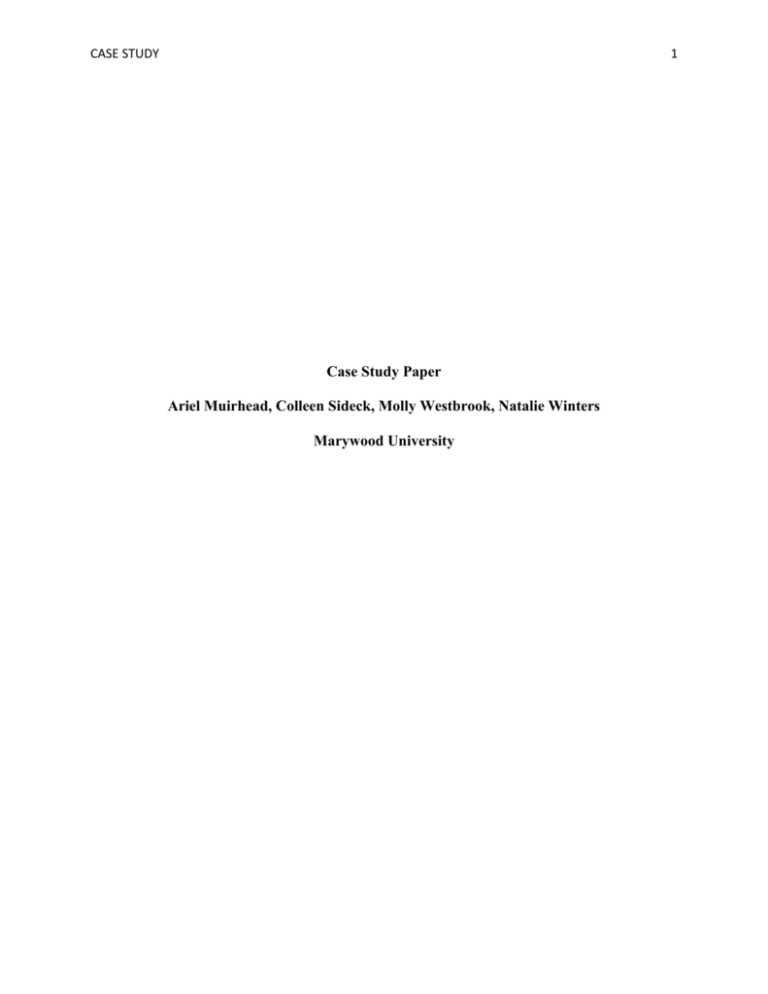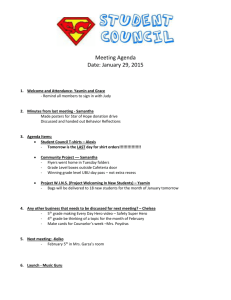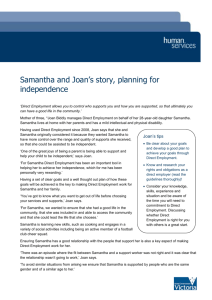Case study paper from Sports Nutrition
advertisement

CASE STUDY 1 Case Study Paper Ariel Muirhead, Colleen Sideck, Molly Westbrook, Natalie Winters Marywood University CASE STUDY 2 Samantha’s Case Study Introduction The case study project being conducted is designed for us to take on an athlete and discuss nutritional status and workout regime. By putting together a series of questions and interviewing the athlete greater insight is achieved into their health status. Questions like what sport do you play, performance goals, what influences eating habits, food preferences, and other relevant questions about her diet are asked in the interview. A DEXA scan, workout schedule, and 3-day food record were asked to be completed by the athlete as well. Description of Athlete The athlete chosen for our case study group is Samantha, a Cross Country athlete at Marywood University. She is a 20 year old, five foot four, one hundred pound, Caucasian female. Samantha is physically smaller in size due to the amount of running she does on a daily basis. Her family history includes high cholesterol, but her reasons for working out are not influenced by this. Description of Training Program Her workout schedule is pretty much set in stone each day, and varies from heavy lifting to running outside to elliptical training. The activities are usually vigorous, and each session lasts more than an hour long; she switches every other day with long runs and short runs. She likes to alternate between the elliptical and running, and incorporates core exercises and heavy lifting into her work out on a daily basis. Description of Personal Goals Samantha has a few personal goals in mind when it comes to training and getting ready for the big race each week. Her first goal for this year was to break 23 minutes on the 6k course, CASE STUDY 3 which she has recently accomplished. Her second goal is to continue to stay healthy and strong throughout the season because as a runner, she tends to lose weight due to the amount of vigorous exercise she does. Currently she is working towards placing higher then certain competitors during the races; time is important to her, but beating out certain people is more crucial. Keeping a healthy weight through the season and eating right are her priorities. She’s focusing on eating enough food, especially protein so she can maintain and build her muscle mass. Recommended Dietary Prescription Daily Caloric Needs. According to Samantha’s BMI (shown below) she is currently underweight because she is under a healthy BMI which is between 18.5 and 24.9. Because of this the group has decided that it is best for Samantha to consume an extra 500kcals daily to promote a one pound weight gain per week. BMI: 101lb/64/64*703=17.33 Mifflin-St. Jeor Equation RMR=(10*Wt(Kg))+(6.25*ht(cm))-(5*age(yr))-161 RMR=460+1018.75-100-161 RMR=1217.75 TER=1.725*1217.75= 2100.61875 (High Activity) 2101+500=2601kcals (Promote weight gain) Harris Benedict RMR= 655+(9.6(Kg))+(1.8*ht(cm))-(4.7*age(yr)) RMR=655+441.6+293.4-94 RMR=1296kcals CASE STUDY 4 2.0*1296kcals= 2592kcals (Highly Active) 2592kcals+500kcals= 3092kcals (Promote weight gain) The group decided to use the Harris Benedict calculation because Samantha is currently consuming over 2800kcals daily and still has a BMI of 17.3. Therefore, to promote weight gain, the group decided that it would be best for her to consume more calories. Acceptable Macronutrient Distribution of Calories. According to nutritional standards, Samantha should be consuming between 20 and 30 percent of her calories from fat and have less than ten percent of those calories coming from saturated fat. In addition, it is important that Samantha consume less than 300mg of cholesterol. Her fat calculations can be seen below. For Samantha’s protein needs, she should be consuming between 1.2/kg/day and 2.0/kg/day or between 12 and 18% and not exceed 35%. This calculation can also be seen below. For Samantha’s carbohydrate requirement, she should be consuming between 45 and 65 percent, and is allowed to consume up to 75% as a maximum. The RDA recommends that she consume at least 130 grams of carbohydrates per day. Below are the calculations. Carbohydrate Recommendation. 101 lbs/2.2 = 46 kg 1. 5-10 g/ kg of body weight 46*5-10 = 230-460 grams CHO/day 2. 45%-65% of total calories/day 3092*0.45-0.65 = 1391-2010 calories from CHO 1391-2010 calories/ 4 each = 348-502 grams CHO/day 3. May go as high as 75% of total calories/day (maximum) 3092*0.75 = 2319 calories from CHO as maximum 2319 / 4 = 580 grams CHO as maximum CASE STUDY 5 Above displays the two methods of determining Samantha’s daily carbohydrate needs. The first determines carbohydrate needs by body weight, being 5-10 grams of protein per kilogram of body weight. This amounted to 230-460 grams of carbohydrates per day. The second was calculated according to the AMDR. It recommended that 46%-65% of Samantha’s total calories for the day should come from carbohydrates. The amount of calories from carbohydrates was found to be 1391-2010 calories, and that was then divided by 4 (because there’s 4 calories/ 1 gram carbohydrates) to get 348-502 grams of carbohydrates per day. The third calculation displays the amount of carbohydrates that the AMDR recommends an athlete should not exceed: 75% of total calories coming from carbohydrates. This amount to stay below is 580 grams of carbohydrates per day. We decided to use the AMDR recommendations for Samantha because they will correlate better with her energy needs since she requires a high daily caloric intake due to her activity level. Protein Recommendation. 101 lbs/2.2= 46 kg 1. 46 kg*1.2-2.0 grams protein/kg = 55.2-92 grams protein 2. 12%-18% of total calories/day 3092 calories/day * 0.12-0.18 = 371-556 calories from protein 371-556 calories / 4 each = 93-139 grams of protein/day 3. Do not exceed 35% 3092*0.35 = 1082 calories from protein 1082/ 4 = 271 grams of protein (do not exceed) Above displays the two methods of determining Samantha’s daily protein needs. The first determines protein needs by body weight, being 1.2-2.0 grams of protein per kilogram of body weight. This amounted to 55.2-92 grams of protein per day. The second was calculated CASE STUDY 6 according to the AMDR. It recommended that 12%-18% of Samantha’s total calories for the day should come from protein. The amount of calories from protein was found to be 371-556 calories, and that was then divided by 4 (because there’s 4 calories/ 1 gram protein) to get 93-139 grams of protein per day. The third calculation displays the amount of protein that the AMDR recommends an athlete should not exceed: 35% of total calories coming from protein. This amount to stay below is 271 grams of protein per day. We decided to use the AMDR recommendations for Samantha because they will correlate better with her energy needs since she requires a high daily caloric intake due to her activity level. Fat recommendation. 20%-30% of total calories/day 3092*0.2-0.3 = 618-928 calories from fat 618-928 calories / 9 each = 69-103 grams of fat/day Above displays how Samantha’s fat needs were determined. The AMDR for fat for athletes is 20%-30% of their total calories for that day. The amount of calories from calories was calculated above and then divided by 9 (because there’s 9 calories/ 1 gram of fat) to obtain Samantha’s fat recommendation of 69-103 grams of fat per day. Daily Fluid Needs. Samantha’s recommended daily fluid intake is approximately 2.7 liters per day. Additionally, because Samantha is an extremely active individual, she should be consuming additional water. These calculations can be seen below. 30mL/Kg wt 30ml*45.9Kg 1380mL 1.38L 1.38L+2.7L= 4.08L (Total daily water) CASE STUDY 7 In addition to the food that Samantha is consuming in her diet analysis, she needs to consume four more additional cups of water or low calories beverage to meet this requirement. Because Samantha does walk and partake in yoga, Samantha could consume more water. The goal is to have urine that is pale yellow in its color. It is beneficial for Samantha to consume the recommended water amount to maintain homoeostasis, as well as to keep her body properly hydrated for her high activity lifestyle. Dietary Recommendation. After calculating Samantha’s daily energy, carbohydrates, protein, fat and water needs, it was appropriate for us to begin formulating a diet plan for her. The main focus of our diet plan was to meet or exceed at least 90% of all of her recommendations for calories, macronutrients, vitamins, minerals, and water without exceeding any upper limits. We also tried to accommodate to foods she enjoys, taking many foods from her 3-day food record, and incorporating them into her new diet plan. Referring to weaknesses of Samantha’s initial diet, we knew that we had to find a way to incorporate more omega-6 fatty acids, folate, and vitamin D, because of deficiencies in them. In order to address her omega-6 deficiency we included nuts, such as peanuts, walnuts and almonds, and seeds. For Samantha’s folate deficiency we added spinach and a variety of bread products to her diet. Vitamin D was a little harder to incorporate in her diet and for her to obtain enough of through food, but we included milk fortified in vitamin D, as well as mushrooms to increase her intake through food items. Even though she’s low in vitamin D, the Women’s Onea-day supplement she takes allows her to obtain enough vitamin D daily because it supplies her with 1000 IUs. Another weakness in Samantha’s initial diet that needed to be addressed was her daily caloric intake. Her initial daily diet was on average 2874 calories and needs to be increased to CASE STUDY 8 about 3092 calories a day according to the Harris Benedict equation which can be seen prior. Our tactic to solve this issue was to give Samantha meals and snacks that were very nutrient dense, but would not cause a sensation of fullness that’s uncomfortable. We also had to be aware of the fact that Samantha lives on campus and will therefore consume most food on campus. One example of a nutrient dense snack for Samantha, which she could also obtain on campus, is a peanut butter-banana smoothie. This smoothie is packed with nutrients, calories, and good flavor, including the ingredients: bananas, peanut butter, cinnamon, nutmeg and soymilk. This snack was also a good choice taste-wise for Samantha because she was including smoothies initial diet; we aim for our diet changes to be not only healthy and beneficial to Samantha’s health and sports performance, but also something she enjoys eating and is familiar to her. Another goal of the group was to also avoid supplementation and protein shakes, with the exception of vitamin D. This leads to the next point: adequacy of vitamins and minerals. Reviewing Samantha’s three day menu it can now be seen that she sufficiently meets all daily requirements for all her vitamins and minerals, disclosing vitamin D. A mineral we believe Samantha should be cautious of is salt. Although her salt intake does not exceed the upper limit, due to the campus food being high in sodium, she should be mindful of this. That being said, because she is an athlete and works out a great deal, she is sweating some of this salt out and therefore makes this even less of an issue. Another item on the diet analysis that should be noted is fiber. Although Samantha’s fiber is high in the diet we’ve prescribed for her, it is still a significantly smaller amount of fiber than she was consuming initially. Lastly, because Samantha is an athlete, she needs to consume more water to account for the amount that she loses when she sweats. Therefore, the group calculated that consuming about 4.1L of water was adequate (refer to calculations under “Daily Fluid Intake Recommendation”). Other than those CASE STUDY 9 items mentioned above, her macronutrients are sufficient as well as her vitamins and minerals. It was not terribly difficult to make sure that Samantha was receiving adequate amounts of both macro and micronutrients because she already had a relatively balanced diet. Strengths, Weaknesses and Recommendations After assessing her three day dietary intake, we determined that the majority of Samantha’s diet is nutrient dense foods, and by consuming a varied and produce-rich diet, Samantha ensures that she receives appropriate amounts of protein, water, fiber, and most vitamins and minerals. By consuming enough protein, Samantha’s body will have the amino acids that her muscles need to recover from vigorous cross-country workouts, and her adequate fat consumption of 77g will provide her body with fat stores that can be used when running long distances. Since her water intake meets her daily fluid needs (DFN), Samantha is helping her body to maintain a normal blood volume and body temperature. This appropriate balance will prevent an excessive rise in body temperature while exercising, and it will ensure that her muscles receive the oxygen that they need to perform at her cross-country events. Since she reports that she does not consume alcohol, Samantha does not have to worry about accidently displacing any vital nutrients with the empty calories from alcoholic beverages that could negatively affect her athletic performance. Although she primarily consumes nutrient-rich foods, Samantha’s caloric intake is insufficient when compared to her extremely high activity level. According to the activities listed on her seven day activity record, Samantha expends a daily average of 517 calories from her practices with the Marywood cross-country team, and on Sunday when her training session was particularly long and intense, she was estimated to be burning about 992 calories. At 5’4”, Samantha’s current weight of 100.8lbs classifies her as underweight with a BMI of 17; therefore, CASE STUDY 10 to promote a weight gain, Samantha must consume an extra 500 calories in addition to her determined daily total energy requirement (TER). During our nutrition consultation, Samantha revealed that her primary performance and body composition goal is to maintain a healthy body weight and body fat percentage, and by including additional calories in her diet plan, Samantha should be able to undergo beneficial weight gain and obtain a healthy BMI. To support her needed weight gain and her intense workout schedule, Samantha should consume approximately 3092 calories. Greater detail on Samantha’s caloric recommendations can be found in the previous Dietary Prescription section of this paper. When looking specifically at Samantha’s protein levels, we determined that her daily protein intake is much too high due to her daily post-workout consumption of protein shakes and bars. After assessing her intake using the Diet Analysis software, Samantha can be seen to consume 193g of protein on average. Samantha’s determined protein needs range from 93g to 139g which is much less than she is actually consuming. By taking in more protein than she needs to perform, Samantha is unnecessarily taxing her kidneys causing them to go into overdrive trying to transform the excess protein into urea for elimination (Fink et al., 2012, 139). In addition, high protein intake causes calcium to be excreted from the bones in attempt to balance the body’s decreasing pH, and these weakened bones put high-impact athletes at a higher risk for fractures (Fink et al., 2012, 140). Since water is needed to metabolize peptide bonds, excessive protein consumption also causes the body to lose water often leading to dehydration and its consequences of decreased athletic performance (Fink et al., 2012, 139). To avoid dehydration and the reduced blood flow that comes with it, Samantha must decrease her daily protein intake to between 93g and 139g, or 12% to 18% of total calories, and she should make sure that she continues to hydrate herself adequately throughout the day. CASE STUDY 11 Samantha’s diet also lacked sufficient amounts of the following nutrients: omega-6 fatty acids, folate, and vitamin D. Since omega-6s are crucial for maintaining brain and bone health, Samantha must increase her daily intake by at least 3g to meet the recommendation of 12g allowing her to stay mentally focused at competition time (Fink et al., 2012, 106). Although many leafy greens, whole grains, and nuts are included her current diet, Samantha did not meet the 400ug daily folate requirement putting her at risk for decreased DNA synthesis and, therefore, increased time needed for tissue repair (Fink et al., 2012, 164). In addition to omega-6s and folate, Samantha’s dietary was seen to be lacking sufficient amounts of vitamin D, only meeting half of the recommended 15ug daily. Without appropriate vitamin D intake, the body will not be able to hold onto calcium; therefore, bones and teeth will gradually become weakened. Due to the location of current town, Scranton, PA, it is unlikely that Samantha can achieve the necessary quantity of vitamin D through sunshine, and she will have to rely on dietary sources to meet the RDA. Since she takes a One-a-Day Woman’s multivitamin daily, Samantha currently receives an adequate amount of vitamin D-- 25ug-- from supplemental sources. Samantha must ensure that she continues to take a vitamin D supplement containing at least 15ug daily as long as she lives in Scranton, and this will allow her to protect her bones from the heavy impact of long-distance running. Since all other vitamins and minerals are readily accessible from dietary sources, it is recommended that Samantha no longer takes her One-ADay Woman’s and her GNC calcium supplements and that she only uses a supplement to meet the RDA for vitamin D. In addition to being deficient in a few nutrients, Samantha’s diet had excessive intake of several vitamins and minerals-- namely niacin, vitamin A, sodium, magnesium, and fiber-putting her at risk for performance-lowering symptoms of toxicity. With a niacin intake of 49mg, CASE STUDY 12 Samantha exceeded the UL of 35mg putting her at risk of headaches, nausea, blurred vision, itchy skin rashes, and glucose intolerance which would ultimately decrease her ability to perform at cross-country events (Fink et al., 2012, 160). If she were to decrease her protein consumption like previously recommended, Samantha would likely simultaneously reduce her niacin intake because the best sources of niacin are protein-rich foods, such as seafood, chicken, peanut butter, and fortified cereals. Another vitamin which Samantha must consume less of is vitamin A, and her intake of 5658ug RAE greatly exceeds the UL of 3000ug RAE making her susceptible to toxicity symptoms such as vomiting, fatigue, and blurred vision. If she does not reduce her vitamin A consumption, Samantha’s performance will suffer from the inability to see her surroundings clearly and to overcome feelings of fatigue and nausea (Fink et al., 2012, 173). Samantha should be advised to moderate her consumption of vitamin A-rich foods, such as carrots, broccoli, romaine lettuce, and milk, choosing to substitute items with lower vitamin A content instead like parsnips, cauliflower, and almond milk. According to the Diet Analysis software, Samantha’s diet contains excess amounts of the minerals sodium and magnesium. With an average sodium intake of 3988mg, Samantha surpasses the UL of 1500mg possibly putting her at risk for toxicity symptoms such as increased blood pressure and calcium excretion (Fink et al., 2012, 201). Although this high intake could cause her heart to work harder and her bones to become weakened, it is likely that Samantha’s sodium consumption is actually necessary for her high level of activity to replace the sodium that she loses through sweating. However, to officially determine the validity of this assumption, Samantha would have to undergo a sweat trial that measures her exact water and electrolyte losses during exercise. Samantha’s diet record also reveals that she exceeds the 350mg UL for magnesium with her consumption of 720mg. Although she exceeds the UL, only 120mg CASE STUDY 13 magnesium comes from the supplemental Accelorade mixture, and since her remaining magnesium intake comes from food sources, Samantha is not at risk of overdosing and experiencing symptoms like muscle weakness, nausea, and vomiting. If she would choose to remove the Accelorade from her diet completely, Samantha would still be consuming enough magnesium to meet her RDA; therefore, the Accelorade supplement is not needed for this purpose. The final nutrient which Samantha consumed in excess is fiber, and while the RDA is 25g, analysis of Samantha’s three day food record showed that she takes in about 59g daily. Although the body needs some fiber to maintain bowel health and blood sugar levels, it is unnecessary for Samantha to be consuming 59g of fiber daily, and she should eliminate the fiber mix that she adds to her recovery shakes so that her body can break down the ingredients into energy sooner (Fink et al., 2012, 86). By avoiding extreme amounts of fiber in her diet, Samantha’s risk for gastrointestinal distress will significantly decrease allowing her to perform to her best ability. Conclusion After assessing Samantha’s intake, it can be seen that there were many strong portions but areas that with minor modifications could be changed for a better overall diet. Overall her carbohydrates and fat were adequate, but her protein was elevated. Because Samantha's initial three-day menu was very nutrient dense, only minor modifications were needed. Overall, the experience of this project was a positive one which enabled the group to better understand how to properly provide nutrition to an athlete. The only minor change that we could see to improve the project would be to have a smaller group. Although our group worked well together, it was sometime difficult to find a time to CASE STUDY 14 meet. Furthermore, it was sometimes also a challenge to collaborate and incorporate our different writing styles into one cohesive paper. References Fink, H.H., Mikesky, A.E., & Burgoon, L.A. (2012). Practical Applications in Sports Nutrition (3rd ed.). Burlington, MA: Jones & Bartlett Learning.





